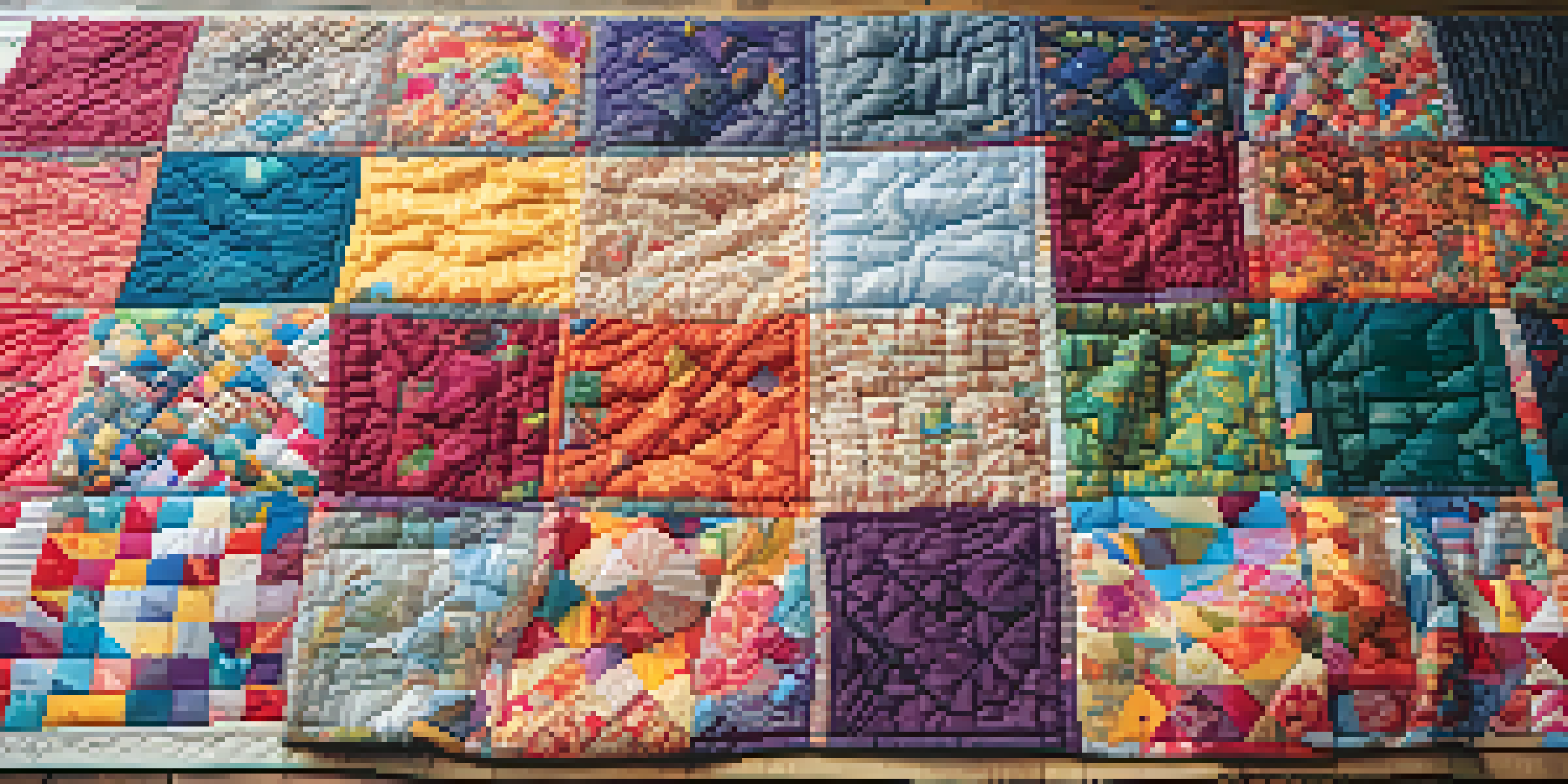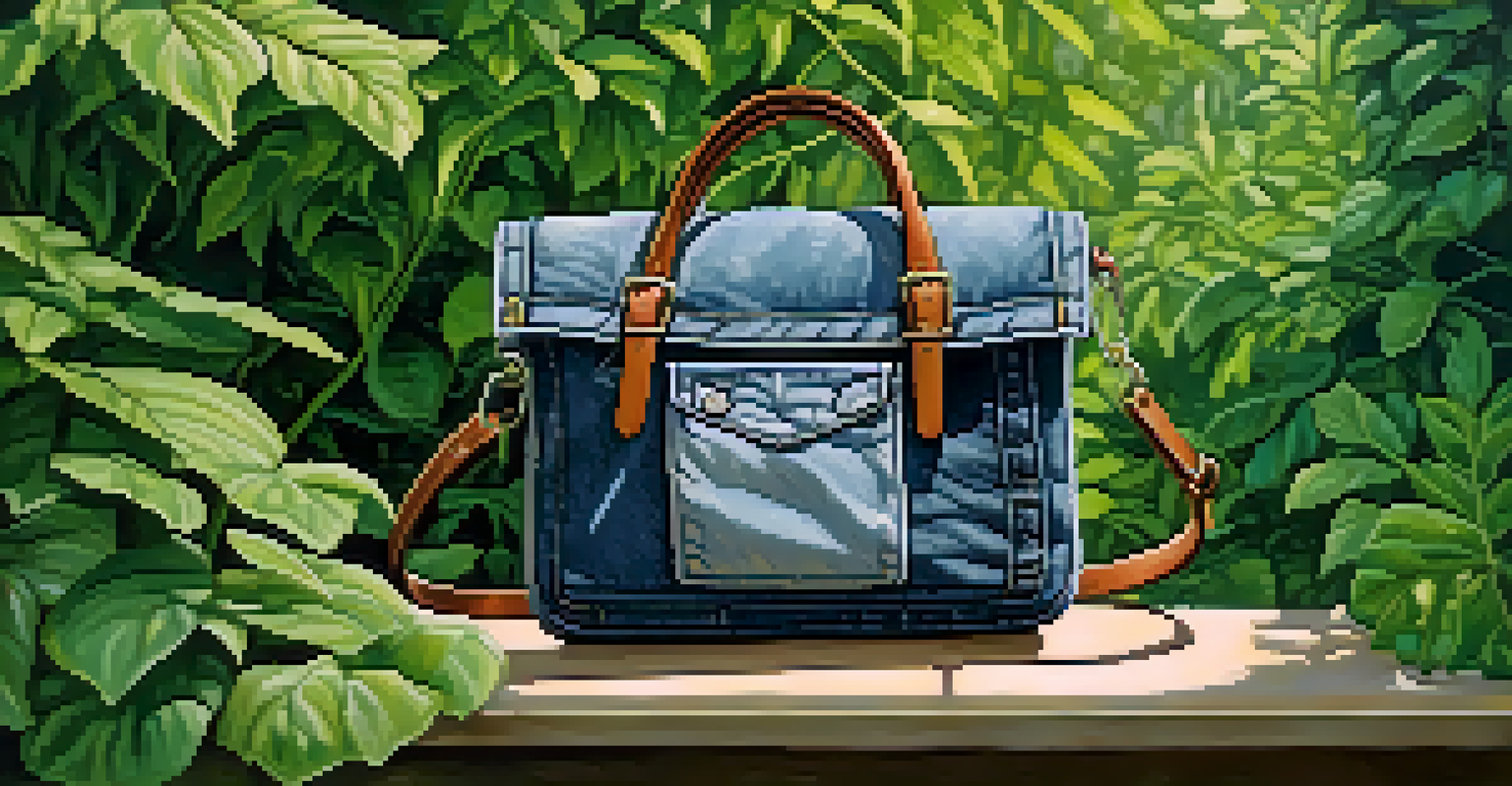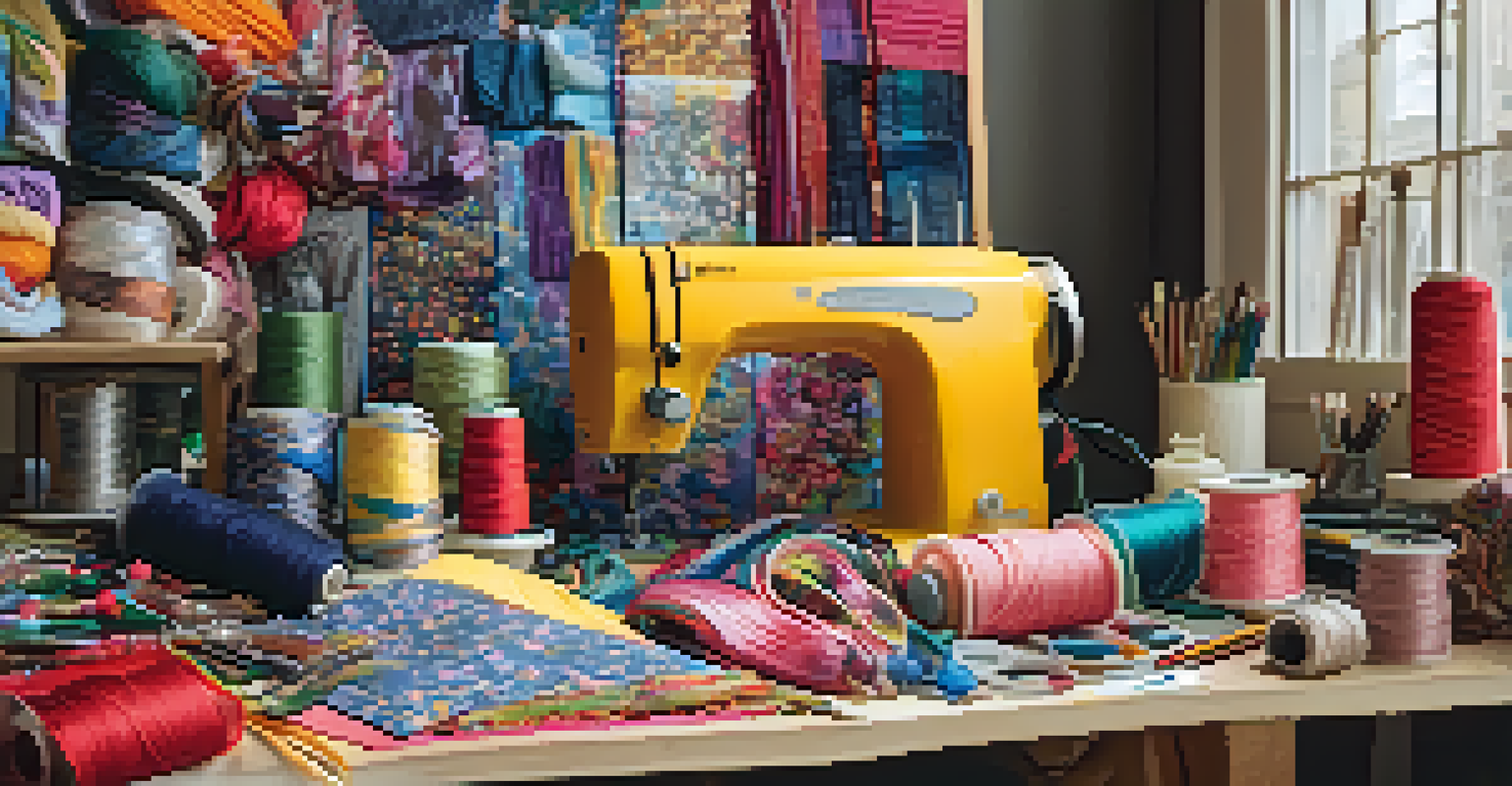Innovative Upcycling Techniques: Transforming Waste into Fashion

Understanding Upcycling: More Than Just Recycling
Upcycling is a creative process that transforms waste materials into new products, often with a higher value than the original item. Unlike recycling, which typically breaks down materials to create something new, upcycling maintains the integrity of the original materials. This approach not only reduces waste but also sparks creativity, allowing fashion designers to reimagine what can be made from discarded items.
One person's trash is another person's treasure.
For instance, a designer might take old denim jeans and turn them into a stylish handbag, showcasing the fabric's unique character while giving it a second life. This transformation speaks to the idea that what we may deem as 'waste' can actually be a canvas for innovation. By embracing upcycling, we’re not just saving materials from landfills; we’re also challenging our perceptions of value and beauty in fashion.
Moreover, upcycling promotes sustainability in the fashion industry, which is notorious for its environmental impact. By reusing materials, designers can significantly reduce their carbon footprint, making a positive contribution to the planet. As more consumers become eco-conscious, upcycling has emerged as a powerful trend that resonates with those looking for stylish yet sustainable fashion choices.
Creative Techniques: Turning Trash into Treasure
There are countless innovative techniques for upcycling materials into fashion items, and creativity knows no bounds. One popular method is patchwork, where scraps of fabric from old garments are sewn together to create vibrant, one-of-a-kind pieces. This technique not only highlights the uniqueness of each fabric but also tells a story of its previous life, making the garment rich with character.

Another exciting technique is the use of plastic bags to create accessories. Designers have been weaving discarded plastic into stylish totes and even jewelry, transforming waste into eye-catching pieces that spark conversation. For example, a simple grocery bag can be upcycled into a chic clutch, making a bold statement about sustainability while remaining fashionable.
Upcycling Redefines Waste in Fashion
Upcycling creatively transforms waste materials into valuable fashion items, challenging our perceptions of beauty and sustainability.
Additionally, some designers are experimenting with dying techniques that use natural materials, like avocado pits or onion skins, to create beautiful colors on fabrics. This not only reduces the need for harmful dyes but also connects consumers to the natural world. These creative methods showcase the endless possibilities of upcycling, encouraging more individuals to see potential in what might have once been considered trash.
The Role of Technology in Upcycling Fashion
In today's digital age, technology plays a pivotal role in the evolution of upcycling techniques. Advanced sewing machines and 3D printing are revolutionizing how designers create upcycled fashion items. For example, 3D printing allows designers to craft intricate pieces from recycled plastics, blending high-tech design with sustainability in a way that was previously unimaginable.
Sustainability isn’t just a trend; it’s a lifestyle choice that we can all make.
Moreover, digital platforms offer a space for upcyclers to share their creations and techniques with a global audience. Social media has become a powerful tool for showcasing upcycled fashion, inspiring others to embrace these practices and join the movement. With hashtags like #UpcycledFashion gaining traction, the community is growing, enabling a larger conversation about sustainability in fashion.
Additionally, online marketplaces dedicated to upcycled goods are thriving, providing designers with a platform to sell their unique items. These resources not only support small businesses but also encourage consumers to choose sustainable options over fast fashion. By leveraging technology, the upcycling movement is gaining momentum, turning waste into fashion on a larger scale.
DIY Upcycling: How to Get Started at Home
Getting started with upcycling at home can be as simple as looking through your closet for items you no longer wear. The first step is to identify pieces that can be transformed, like an old t-shirt that could be turned into a trendy tote bag. There are countless DIY tutorials available online that guide you through the process, making it accessible for anyone to try their hand at upcycling.
One enjoyable project is to create a patchwork quilt from old clothing. This not only recycles fabric but also preserves memories associated with those garments. By stitching them together, you create a unique piece that tells a story, all while giving new life to what might have ended up in the trash.
Technology Enhances Upcycling Efforts
Advancements in technology, like 3D printing and digital platforms, are revolutionizing upcycling by enabling designers to create and share their sustainable creations.
Additionally, consider hosting an upcycling party with friends. Gather old clothing and materials, and spend the day brainstorming and creating together. Not only is this a fun way to spend time with friends, but it also fosters a creative environment where everyone can share ideas and techniques. Upcycling can be a rewarding and enjoyable experience, turning waste into something beautiful and functional.
Famous Designers Leading the Upcycling Movement
Several designers have gained recognition for their commitment to upcycling, showing the fashion world that sustainability can be chic. For instance, Stella McCartney is known for her eco-friendly practices and has incorporated upcycled materials into her collections. Her designs prove that luxury fashion can align with environmental consciousness, setting a powerful example for others in the industry.
Another notable figure is the brand Reformation, which focuses on sustainable practices, including the use of upcycled materials. They create trendy clothing that appeals to a younger audience, demonstrating that fashion and sustainability can coexist harmoniously. Their approach has inspired many to rethink their shopping habits and consider the impact of their choices.
Moreover, designer Annika Inez has gained attention for her innovative use of vintage clothing, turning them into modern, wearable art. By repurposing items that may have been overlooked, she illustrates how creativity can breathe new life into the fashion industry. These pioneers are not only making a statement with their designs but also encouraging a shift toward more sustainable practices in fashion.
The Impact of Upcycling on Consumer Behavior
As more consumers become aware of the environmental impact of fast fashion, upcycling has started to influence buying habits. Many shoppers are now seeking out sustainable options, showing a preference for brands that prioritize eco-friendly practices. This shift in consumer behavior is pushing companies to adopt upcycling methods, promoting a more sustainable fashion industry.
Moreover, the unique nature of upcycled items appeals to consumers looking for one-of-a-kind pieces. Shoppers are increasingly valuing individuality over mass-produced items, leading to a growing demand for upcycled fashion. This trend not only supports sustainable practices but also allows consumers to express their personal style in a meaningful way.
Consumer Demand Drives Sustainability
As consumers increasingly prioritize eco-friendly options, upcycled fashion is gaining popularity, influencing buying habits and supporting sustainable practices.
Additionally, educational campaigns around the importance of sustainability are helping to raise awareness regarding the benefits of upcycling. As consumers become more informed, they are more likely to support brands that align with their values. The growing interest in upcycled fashion reflects a broader cultural shift towards mindfulness and responsibility in consumer choices.
Future Trends: What's Next for Upcycling in Fashion?
Looking ahead, the future of upcycling in fashion seems promising, with new trends emerging that continue to push the boundaries of creativity. One potential trend is the integration of technology into the upcycling process. As designers explore innovative ways to use AI and machine learning, we may see even more sophisticated designs that maximize the potential of recycled materials.
Additionally, collaborative projects between brands and upcycling artists are likely to gain traction. These partnerships can lead to unique collections that draw attention to the importance of sustainability while appealing to a diverse audience. By combining the skills of established brands with the creativity of upcyclers, we can expect to see exciting and original fashion pieces hitting the market.

Finally, as consumers demand more sustainable options, we can anticipate a rise in educational programs focused on upcycling. Workshops and courses that teach individuals how to upcycle their own clothing can empower communities and foster a culture of creativity and sustainability. The future of upcycling in fashion is bright, and it promises to be an exciting journey toward a more sustainable world.